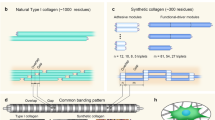Abstract
Collagen is the most abundant fibrous protein in nature and widely exists in tissues such as connective tissue, tendon, skin, bone, and cartilage. On the one hand, collagen provides mechanical support in tissues, and on the other hand, plays an important role in controlling cell adhesion, cell migration, and tissue repair. A systematic understanding of the structure of collagen can promote the understanding of the biological functions of collagen scaffolds, and also provide theoretical guidance for applications of these natural fibrous protein materials. Therefore, this chapter centers on introducing the structure of collagen. As collagen has a typical hierarchical structure, the introduction to its structure will also be divided into different structural levels, from primary structure to quaternary structure. Due to the diversity of collagen types, this chapter will mainly focus on type I collagen.
Access this chapter
Tax calculation will be finalised at checkout
Purchases are for personal use only
Similar content being viewed by others
References
Zhu S, Yuan Q, Yin T, You J, Gu Z, Xiong S, Hu Y (2018) Self-assembly of collagen-based biomaterials: preparation, characterizations and biomedical applications. J Mater Chem B 6(18):2650–2676
Liu DS, Nikoo M, Boran G, Zhou P, Regenstein JM (2015) Collagen and gelatin. Annu Rev Food Sci Technol 6:527–557
Abou Neel EA, Bozec L, Knowles JC, Syed O, Mudera V, Day R, Hyun JK (2013) Collagen-emerging collagen based therapies hit the patient. Adv Drug Deliv Rev 65(4):429–456
Gomes S, Leonor IB, Mano JF, Reis RL, Kaplan DL (2012) Natural and genetically engineered proteins for tissue engineering. Prog Polym Sci 37(1):1–17
Ling S, Chen W, Fan Y, Zheng K, Jin K, Yu H, Buehler MJ, Kaplan DL (2018) Biopolymer nanofibrils: structure, modeling, preparation, and applications. Prog Polym Sci 85:1–56
Barthelat F, Yin Z, Buehler MJ (2016) Structure and mechanics of interfaces in biological materials. Nat Rev Mater 1(4):16007
Markus JB (2006) Nature designs tough collagen: explaining the nanostructure of collagen fibrils. PNAS 103(33):12285–12290
Fratzl P (2008) Collagen: structure and mechanics. Springer, New York
Cisneros DA, Hung C, Franz CM, Muller DJ (2006) Observing growth steps of collagen self-assembly by time-lapse high-resolution atomic force microscopy. J Struct Biol 154(3):232–245
Cen L, Liu W, Cui L, Zhang W, Cao Y (2008) Collagen tissue engineering: development of novel biomaterials and applications. Pediatr Res 63(5):492–496
Zeugolis DI, Raghunath M (2011) Collagen: materials analysis and implant uses, in comprehensive. Biomaterials 2:261–278
Ervin H, Epstein JR (1974) [α1(III)]3 human skin collagen. J Biol Chem 249(10):3225–3231
Coppola D, Oliviero M, Vitale GA, Lauritano C, D’Ambra I, Iannace S, Pascale B (2020) Marine collagen from alternative and sustainable sources: extraction, processing and applications. Mar Drugs 18(4):214
Orgel JPRO, Irving TC, Miller A, Wess TJ (2006) Microfibrillar structure of type I collagen in situ. PNAS 103(24):9001–9005
Williams BR, Gelman RA, Poppke DC, Piez KA (1978) Collagen fibril formation. Optimal in vitro conditions and preliminary kinetic results. J Biol Chem 253(18):6578–6585
Di Lullo GA, Sweeney SM, Korkko J, Ala-kokko L, San Antonio JD (2002) Mapping the ligand-binding sites and disease-associated mutations on the most abundant protein in the human, type I collagen. J Biol Chem 277(6):4223–4231
Hafner AE, Gyori NG, Bench CA, Davis LK, Šarić A (2020) Modeling fibrillogenesis of collagen-mimetic molecules. Biophys J 119(9):1791–1799
Fratzl P, Weinkamer R (2007) Nature’s hierarchical materials. Prog Mater Sci 52(8):1263–1334
Ottani V, Martini D, Franchi M, Ruggeri A, Raspanti M (2002) Hierarchical structures in fibrillar collagens. Micron 33(7–8):587–596
Gautieri A, Vesentini S, Redaelli A, Buehler MJ (2011) Hierarchical structure and nanomechanics of collagen microfibrils from the atomistic scale up. Nano Lett 11(2):757–766
Liu X, Zheng C, Luo X, Wang X, Jiang H (2019) Recent advances of collagen-based biomaterials: multi-hierarchical structure, modification and biomedical applications. Mater Sci Eng C Mater Biol Appl 99:1509–1522
Tang K (2012) Collagen physics and chemistry. China Science Publishing & Media Ltd, Beijing
Shoulders MD, Raines RT (2009) Collagen structure and stability. Annu Rev Biochem 78:929–958
Sorushanova A, Delgado LM, Wu Z, Shologu N, Kshirsagar A, Raghunath R, Mullen AM, Bayon Y, Pandit A, Raghunath M, Zeugolis DI (2019) The collagen suprafamily: from biosynthesis to advanced biomaterial development. Adv Mater 31(1):1801651
Yang W, Meyers MA, Ritchie RO (2019) Structural architectures with toughening mechanisms in nature: a review of the materials science of type-I collagenous materials. Prog Mater Sci 103(6):425–483
Sanders JE, Goldstein BS (2001) Collagen fibril diameters increase and fibril densities decrease in skin subjected to repetitive compressive and shear stresses. J Biomech 34(12):1581–1587
Sivakumar L, Agarwal G (2010) The influence of discoidin domain receptor 2 on the persistence length of collagen type I fibers. Biomaterials 31(18):4802–4808
Eyre D (2002) Collagen of articular cartilage. Arthritis Res 4(1):30–35
Kadler KE, Baldock C, Bella J, Boot-Handford RP (2007) Collagens at a glance. J Cell Sci 120(12):1955–1958
Acknowledgments
This work was supported by the National Natural Science Foundation of China [grant numbers. 51973116, U1832109, 21935002], the Users with Excellence Program of Hefei Science Center CAS [grant number 2019HSC-UE003], the starting grant of ShanghaiTech University, and State Key Laboratory for Modification of Chemical Fibers and Polymer Materials.
Author information
Authors and Affiliations
Corresponding author
Editor information
Editors and Affiliations
Rights and permissions
Copyright information
© 2021 Springer Science+Business Media, LLC, part of Springer Nature
About this protocol
Cite this protocol
Zhao, C., Xiao, Y., Ling, S., Pei, Y., Ren, J. (2021). Structure of Collagen. In: Ling, S. (eds) Fibrous Proteins. Methods in Molecular Biology, vol 2347. Humana, New York, NY. https://doi.org/10.1007/978-1-0716-1574-4_2
Download citation
DOI: https://doi.org/10.1007/978-1-0716-1574-4_2
Published:
Publisher Name: Humana, New York, NY
Print ISBN: 978-1-0716-1573-7
Online ISBN: 978-1-0716-1574-4
eBook Packages: Springer Protocols




